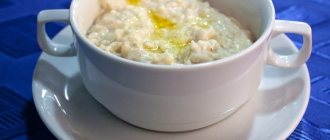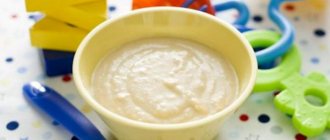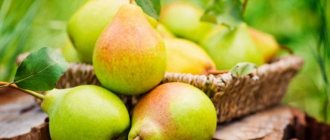What diet is suitable for a one-year-old child?
Already at 5-6 months you should begin to introduce new foods into the diet. By the age of one year, the menu should be varied and rich. However, only approved products must be used.
The main food that the baby consumed up to a year remains in the diet: porridge, fermented milk products, meat, as well as vegetables and fruits. In addition to the products listed, the diet will be constantly supplemented and expanded, and there will also be changes in the combination of products and the duration of breaks between meals.
- You should not immediately eliminate breast milk or formula after one year. The child should gradually switch to other foods, and over time the diet will be similar to an adult with breakfast, lunch, afternoon snack and dinner.
- If up to a year the portions were very small, then at this age they should be increased.
- At 1 year of age, the child begins to grow actively. He develops various reflexes, including chewing. There is no need to constantly prepare food with a fine consistency for your baby. You can, for example, give your child a cracker to “chew.”
- With age, the baby's need for proteins, fats and carbohydrates increases. The diet must include fish or meat. It is important that the products are fresh and of high quality. The child’s body is very sensitive, so buy products only from trusted places.
- If the baby is fed mother's milk, then breastfeeding should be continued at 1 year. In addition, you need to saturate your diet with fermented milk products such as kefir and cottage cheese.
- You can prepare meat broths; the dishes should be boiled or stewed.
- There is no need to overdo it with salt consumption. Sugar should also be added in minimal quantities.
The diet for 1 year must include fish and meat
Oatmeal with banana
Oatmeal with banana is a quick and satisfying breakfast option. You can prepare porridge with water or milk.
Ingredients
- instant oatmeal - 3 tbsp. l.;
- banana – 1 pc.;
- sugar – 1 tsp;
- water – 150 ml;
- milk – 50 ml.
Step-by-step cooking process
- Bring 150 ml of water to a boil in a saucepan and pour oatmeal into the container.
- Boil the oatmeal over low heat for 3 minutes, stirring constantly. Remove the pan from the stove and cover with a lid.
- Boil the milk separately and pour it into the pan with oatmeal.
- Mash the banana with a fork and add to the oatmeal.
How to serve a dish
Breakfast for a 1 year old child is served in a deep plate. The porridge is supplemented with butter and sugar.
List of allowed products for a one-year-old child
From 1 year to 1.5 years, nutrition should be approximately the same. In general, the calorie content of daily food consumption should not exceed 1300 calories. It is also worth considering that everyone develops differently. Some children are more active, which means they need to consume more calories, while others, on the contrary, refuse larger portions. Nevertheless, with any development, the following products must be present in the diet of a one-year-old child:
- breast or artificial milk;
- dairy products;
- porridge;
- meat and fish products;
- vegetables and fruits.
You can use not only meat and fish as protein, but also boiled eggs. At this age, bread and cookies are allowed. But these products should be given to the child in small quantities. Juices based on natural ingredients are welcome. The choice of vegetables and fruits will depend on seasonality, since it is during this period that these products are most rich in beneficial microelements.
All listed products are allowed at the age of 1 year. You can prepare various healthy dishes from them, because at this time the most important thing is variety.
When choosing a protein product, you should prefer one thing. You should not combine, for example, fish and eggs. Separately, protein products are used twice a week.
Some nutrition rules
The child's transition to adult food should be gradual. The diet is changed as follows: to train the masticatory apparatus, more dense and solid food is introduced, and liquid and semi-liquid food is gradually reduced.
To prevent your baby from turning away from a new dish, try using a simple rule: food should look attractive and smell delicious. It is the aroma and appearance of “goodies” that trigger the process of gastric juice production. By the way, bright dishes will serve as an excellent assistant in this matter.
During the meal, do not place all the prepared dishes in front of the baby; the baby should receive the next portion only when he has eaten the previous one.
Make at least one meal a family meal, even if the child’s overall diet does not coincide with yours.
Gradually teach your child to set and clear the table. A three-year-old child can already be asked to wash the dishes.
An approximate set of products for one day for children 1-1.5 years old
| Products | Unit. | Quantity |
| Milk | ml | 600 |
| Bread | G | 40 |
| Cereals, pasta | G | 20 |
| Potato | G | 100 |
| Various vegetables | G | 150 |
| Fruits | G | 100 |
| Juices | ml | 100 |
| Meat | G | 60 |
| Fish | G | 25 |
| Cottage cheese | G | 50 |
| Yolk | PC | 0,5 |
| Vegetable oil | G | 4 |
| Butter | G | 12 |
| Sugar | G | 40 |
| Salt | G | 3 |
Basic principles of nutrition at 1 year
It is advisable to eat 4 times a day at this age. Small snacks are also available. Breakfast makes up 25% of the diet. You can have a snack before your next meal. At lunch you need to eat 35% of your daily requirement. Next comes the afternoon snack, which is 15%. The same amount remains for dinner as for breakfast.
The breaks between meals for the baby should not be too long. Ideally, you should eat every 3, maximum 4 hours. You also need to ensure that meals are taken at approximately the same time every time. You need to accustom yourself to this both in childhood and at an older age, since the body gets used to strengthening the functioning of the digestive tract at a certain time, which means that there will most likely be no problems with digestion.
Despite the fact that the child is getting teeth and feels the need to “chew” something, the food should not be of too coarse consistency, like that of an adult. At 1-2 years of age, basic food products should still be chopped. It is allowed to eat pieces no larger than 3 cm.
How to feed your baby correctly
It is known that from a young age children love sweets, and to cheer up their child, parents often pamper their child with sweets. In addition to the fact that they do not bring any benefit, they will become addictive over time, and the baby will constantly demand a treat. There is no need to eat a lot of sweets at 1 year of age, and it is better to replace chocolate and sweets with homemade jam or honey.
Each new product in the baby’s diet should be introduced gradually. First you should make sure that there are no allergies or any other negative reactions. Only after this can you eat the product, initially eating it in the morning, since at this time food is better digested than in the evening. You can’t start eating a lot of new foods right away either. Everything should be gradual, but the most important thing is how the child will feel and react to innovations in nutrition.
It is best to eat about 5 times a day. The child should have a full breakfast, second breakfast, lunch, afternoon snack and dinner. If a child has a desire to eat before bed, it is better to satisfy this need and please the baby with some light treat: cookies or cottage cheese.
At 1 year of age you need to eat 5 times a day
Breakfast
The day begins with breakfast not only for an adult, but also for a one-year-old child. The standard breakfast option is porridge. It can be cooked in both water and milk. At 1 year of age, the variety of cereals increases: the child can be fed oatmeal, wheat, or semolina porridge. You can choose gluten-free cereals if you have an allergy, such as buckwheat porridge. You should not choose semolina too often, as many children develop allergies, and compared to other cereals, semolina is not as healthy. So, many mothers prefer pumpkin, corn or rice porridge for breakfast for their baby. Separately, you can eat fruit puree, not very crushed, with pieces of fruit. Or combine them with porridge. You should not be afraid to diversify your baby’s diet, as he is interested in learning something new and eating delicious dishes.
At 1 year of age, it is better to limit yourself to porridge and maximum fruit. A little older, one and a half or two years old, is allowed to diversify the breakfast. For example, you can eat a boiled egg. Once a week you should prepare an omelette from 1 egg and milk. This dish can be varied with herbs. At 1 year of age, you can already eat dill; do not forget about its benefits and vitamin content, which will only contribute to the development of the child.
At this age, you can already eat bread and butter, so these products should also be included in the diet. Just choose bread that is not rye or refined, as these products can cause problems with stool. It is better to make children's sandwiches using white flour bread rather than a loaf, as it is better absorbed by the body. You definitely need to drink something for breakfast. The juice must be fresh and the tea not strong. They also prefer compote or jelly from liquid.
For breakfast, choose a variety of cereals
Lunch
The second breakfast is also called lunch - this is the period when after breakfast the child is already hungry, and lunch is still far away. Active kids especially need to eat frequently and variedly. During this period, it is useful to eat some fruit or prepare fruit puree for your child. You can eat baby yogurt, just plain one, without fillers or colorings. Thanks to fruits, the functioning of the digestive tract improves. In addition, they stimulate appetite, because this is a very common problem for one-year-old babies.
For second breakfast, mothers also prefer biscuits. It's best not to give your baby crackers, chocolate chip cookies, or candy just yet. These products, on the contrary, will ruin your appetite and will not bring any benefit.
Often the second breakfast is combined with a walk. Because of this, mothers may neglect meals, but, of course, this is not worth doing. On the contrary, it will be very interesting for the baby to snack on some children’s yogurt from the store while he groceries. Walks bring positive emotions, and delicious food will further lift the child’s mood.
Dinner
The most important stage of the daily diet is lunch. It should be complete, satisfying and not harmful. During the day you should definitely eat vegetables. They are used as a puree in crushed form and also individually raw. At 1 year old, you can eat a vegetable salad consisting of tomato, cucumber, cabbage and other products. It is useful at this age to eat carrots raw. You can also make soup from vegetables. At this age, it is acceptable to eat noodle soup, but not more than once a week.
Meat will be combined with vegetable puree. Each time the dish can be supplemented with new products that have not been used before: beets, beans and others. You can and should still eat mashed potatoes. However, you should be careful with it too.
It is not recommended for a one-year-old child to eat potato dishes too often, as this product contains a large amount of starch. It can cause weight gain, bloating, and gas.
For meat, you should first start with veal or beef. Meat products should be eaten boiled as puree or cutlets. It is better not to start eating meat soups yet. A little after a year, you can carefully switch to chicken. You should not eat pork, lamb and other types of meat that are difficult to digest. It is better to eat them after 3 years of life. Sausages are also not allowed yet. The digestive tract is not yet developed enough to digest such foods.
At 1 year of age, you can start eating low-fat fish. It should not be consumed too often if the parent has only introduced it to their child’s diet. Portions should be small, no more than once a week.
So, lunch should include various dishes, but the required components are vegetables, meat or fish. After a full lunch, you should drink fresh juice or compote.
Afternoon snack
An afternoon snack is a meal after a nap. At this time, fermented milk products such as kefir and cottage cheese are suitable. You can diversify your diet by preparing sweet treats from these products: pancakes or cheesecakes. It is better to feed such products to a baby starting from 1.5 years old, as they are a little more difficult to digest. The afternoon snack must necessarily contain fruit; for a one-year-old baby, it should be in crushed form. Sometimes it’s worth pampering your child with cookies: biscuits or baked milk.
You should be careful when choosing fermented milk products. You need to choose products specifically for children, as they are the safest and healthiest. Regular store-bought cottage cheese can be used to make other treats.
Children may not be accustomed to switching to regular milk after breast milk, which is why many babies experience tummy pain during the sudden transition. Everyone's reaction to cow's milk is individual, so you should be very careful when including this product in your diet.
Detailed menu for the week
To ensure your baby’s nutrition is complete and balanced, it is recommended to prepare a diet for every day for a week. This method will help you understand what your baby is missing and how varied and rich his diet is.
At 1 year old, the baby’s digestive tract is very sensitive, he cannot eat too large foods, everything must be crushed. There are also a number of foods that are not advisable to give to a child at this time. Their choice must be approached carefully and selectively, and the selection of meals for the week will help to better see the overall picture of the daily diet. Let's look at a sample meal plan for a week.
| Breakfast | Dinner | Afternoon snack | Dinner | |
| Monday | Soup, omelette, bread | Mashed potatoes, cutlet, bread | Cookies and tea, fermented milk product | Vegetable puree, fermented milk product, tea |
| Tuesday | Porridge, compote, bread | Vegetable puree, meat dish, bread | Curd mixture, fruit | Cottage cheese, fruit, tea, bread |
| Wednesday | Porridge, compote, bread | Vegetable puree, fish dish, bread | Kefir with cookies | Vegetables, carrot puree |
| Thursday | Porridge, tea, bread | Vegetable soup, vegetables, bread | Curd mixture, fruit | Fish dish, mashed potatoes, bread |
| Friday | Porridge, tea, bread | Soup, cutlets, mashed potatoes, juice | Fruit, cookies, fermented milk product | Fruit puree, fermented milk product, bread |
| Saturday | Omelette, bread, compote | Vegetable puree, cutlets, bread | Fruit, cookies, fermented milk product | Meat dish, bread, compote |
| Sunday | Cheesecakes, tea | Meat soup, vegetable puree, bread | Fruit, fermented milk product | Porridge, bread, milk |
As you can see from the table, porridge is the main component of breakfast. Periodically, a one-year-old child should be given cheesecakes or an omelet. During the afternoon snack, it is advisable to eat any fermented milk product or dishes made from cottage cheese and kefir. For lunch and dinner you should definitely eat meat and vegetable dishes. There are a number of recipes that are suitable for children 1 year old.
Creating a weekly meal plan will help make your diet balanced
Lazy dumplings with berries
Breakfast for a 1 year old child can be tasty and varied. Instead of the usual porridge, you can serve lazy dumplings, supplementing them with children's pasty cottage cheese and berries.
Ingredients
- cottage cheese 5% – 250 g;
- egg – 1 pc.;
- rice flour – 4 tbsp. l.;
- sugar – 2 tsp;
- salt - a pinch;
- butter – 5 g;
- children's cottage cheese – 100 ml;
- cherry – 50 g.
Step-by-step cooking process
- In a deep bowl, mix cottage cheese, egg, sugar and salt. After this, add flour and knead the dough, which should not stick to your hands. If necessary, you can add more flour.
- Roll out the dough into a sausage and cut into pieces 2 cm wide.
- Pour 2 liters of water into the pan and bring to a boil, then add salt.
- Place the dumplings into boiling water and boil for 3 minutes.
- Place the finished dumplings in a bowl and grease with butter.
How to serve a dish
Dumplings are placed on a plate, topped with baby cottage cheese and decorated with pitted cherries.
Recipes for children 1 year old
Let's consider the main options for preparing dishes for tomorrow, lunch and dinner.
Rice porridge with dried fruits
Cooking method:
- Wash dried fruits and place in water. Cook until softened.
- Then the stove must be turned off, leaving the dried fruits in the water.
- After this, you need to remove the dried fruits and boil the water again, adding a little salt.
- Place rice in salted water and add milk.
- After cooking, combine with dried fruits and sugar.
Rice porridge with dried fruits
Semolina porridge with pumpkin
A very simple breakfast recipe for a one-year-old child. Kids love pumpkin porridge and eat it with great pleasure. Besides that, it is extremely useful.
Cooking method:
- Cut the pumpkin into small pieces and cook until softened.
- Next, add semolina, mix and cook until tender.
- Sugar the dish and you can serve it to your child.
For lunch, you need to choose a dish containing vegetables and meat. Puree or soup will do.
This is interesting: Feeding a baby: tips, rules and recommendations in the first month
Vegetable soup
Potatoes, carrots and turnips are used as the main products for the dish.
Cooking method:
- Wash, peel and chop the indicated vegetables.
- First place carrots and turnips in the pan and cook for 20 minutes, then the rest of the products.
- After the vegetables are cooked, they should be chopped to the desired consistency.
- Salt the resulting dish and add cream.
Creamy rice soup
A fairly common and rich lunch for a one-year-old child. A favorite dish for kids, as it is very filling, healthy and tasty. And it’s extremely easy to prepare. To create this dish you will need rice, carrots and cauliflower.
Cooking method:
- First you should cook the rice and salt it.
- Grind the vegetables to give the required consistency.
- Combine all products and boil. Add salt to taste and the dish is ready.
Rice and cauliflower soup
Cutlets
From meat and fish dishes you can prepare soufflé, liver puree or fish cabbage rolls. The simplest recipe for a meat dish is cutlets. For cooking it is better to use beef meat. Bread and water will also come in handy.
- Grind the meat using a meat grinder.
- Soak the bread in water.
- Combine the bread with the meat and grind through the meat grinder again.
- Salt the resulting minced meat and add water.
- Fill the pan with water and place the cutlets there. Leave them to simmer for half an hour.
Liver puree
Another recipe that is suitable for a full lunch or dinner is beef liver puree. Many children do not like this product, but its benefits are very great, especially for the baby’s fragile body. At least once a week, the diet should include a liver dish. The peculiarity of this product is the presence of a huge amount of microelements and vitamins A and B. The benefit for children is that beef liver strengthens the immune system, which is very important at this age. Consider the method of preparing liver puree:
- The washed liver is finely chopped.
- Lightly fry the crushed product.
- Next, transfer the liver and fill it with boiled water. Keep covered for about 10 minutes.
- After the time has passed, chop a few more times and add salt to taste.
- Next, add milk and boil the puree. The dish is ready and can be served.
Liver puree
What does an eight month old baby's diet include?
When all the main types of products have been introduced, the children's diet should be diversified. Pediatricians suggest preparing both “pure” and combined dishes, for example, not only berry, fruit and vegetable purees, but also their combinations with cottage cheese and cereals.
Porridge in the diet
It does not matter in what order the different types of cereals are introduced. Children have different preferences, so it is better to accustom them to all options: buckwheat, rice, corn. It is usually recommended to start with a teaspoon of porridge, if the baby likes it, gradually increase the portion to 2-3 tablespoons.
Vegetables on the menu
Greens and vegetables are introduced into the menu fresh, boiled or steamed. Children of the eighth month are offered carrots, zucchini, pumpkin, broccoli and many other vegetables.
Fruits for complementary feeding
Apples, bananas, pears, plums are introduced for complementary feeding raw, in small pieces or steamed in the form of puree.
Meat in the diet
Pediatricians consider meat a healthy product for children in their first year of life. To prepare it, you need to scroll it several times, then rub it through a sieve. The diet should include rabbit, turkey, veal, beef, and chicken.
To introduce complementary feeding, the correct consistency of food and the attractive appearance of the dish are important.
Fish in the diet of an 8 month old baby
Fish can be introduced into the diet of an eight-month-old baby - a source of complete protein containing amino acids, fat, vitamins B2, B12 and minerals. Children need them for brain maturation, strengthening the retina, cardiovascular and immune systems.
It is recommended to give the baby fish 1-2 times a week, alternating with meat, and monitor how he tolerates it. Preference is given to white ocean fish (cod, hake, pollock), and red salmon.
Eggs on the children's menu
Eggs are also included in the children's menu, as they contain useful substances for strengthening bones and functioning of the thyroid gland.
For your information. Egg whites often cause allergic reactions in children, so complementary feeding starts with the yolk.
First, a quarter of the yolk dissolved in milk is given for testing. If the baby does not have loose stools, then the portion can be increased each time, reaching the end of the month to a whole
Protein is introduced with great care into a child’s diet in the eighth month.
Dairy products
Complementary feeding for an 8-month-old child can be expanded by introducing fermented milk products, for example, kefir, bio-yogurt, cottage cheese. Made with a special leaven, they provide the baby with a set of amino acids in an accessible form and have a beneficial effect on the functioning of the intestines. They are introduced into the diet gradually, starting with one teaspoon, increasing the portion to 150-200 g per day.
Useful tips
The basic principles of nutrition, recipes and daily weekly diet have already been discussed. And in conclusion, some tips for mothers so that no problems arise with the nutrition of their one-year-old child.
- Very often, children lose their appetite and refuse to eat precisely because of a violation of their diet. You should not feed your baby at different times all the time, as this may cause loss of appetite. In order for the body to fully absorb food and be ready to consume it, you need to eat constantly at the same time.
- Eating problems also arise on a psychological level. For example, if a baby is “forced” to eat, then of course this meal will cause denial in him. He must realize that nutrition is a joyful period. To do this, the food must be healthy so that the child feels good after taking it. The delivery and attitude of the mother towards feeding is important. If she happily offers the baby food, he will eat it with the same pleasure.
- On a psychological level, the child will want to eat more if other people do it. Try to eat with your baby, or better yet, with the whole family, so that the child immediately understands that lunch or dinner is a family meal. You can lay out the toys and feed them too. If you combine food with play, the child will become more interested in nutrition.
- If your baby doesn’t like a certain product, but it is very healthy, you don’t have to exclude it from the diet, just add it discreetly to some dish.










